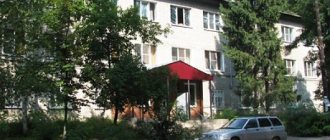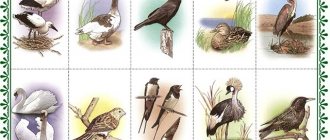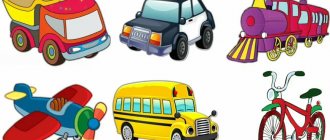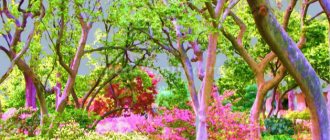Notes on cognitive development Topic: “My city” for middle group children
Transcript
1 Municipal budgetary preschool educational institution combined type kindergarten 49 “FAIRY” Abstract on cognitive development Topic: “My city” for children of the middle group Prepared by: teacher Margarita Nikolaevna Luneva, Stavropol, 2016
2 Topic: “My City” Goal: Continue to introduce children to their small homeland. Objectives: - Expand children's ideas about their hometown; — To evoke in children a feeling of admiration for the beauty of their hometown; — Teach children to draw a big house, convey the rectangular shape of the walls, rows of windows. — Develop the ability to complement the image based on impressions of the surrounding life. — To cultivate a love for one’s hometown and a sense of pride in it, a desire to make it even more beautiful. Vocabulary work: the city of Stavropol, names of streets, names of buildings (hospital, library, school, kindergarten, store). Materials: Photo stand “My Favorite City”, album sheets for drawing, wax pencils, recording of the song “Stavropol”. Preliminary work: city tour, memorizing poems about the city, looking at the photo album “The Nature of Our City,” conversations about the city of Stavropol, outings with children, application “Houses of the City.” Progress of the lesson: Educator: Guys, let's stand in a circle. Show your palms. Rub them together. What do you feel? (Warm). This is the warmth of kind hands and kind souls. We offer our warmth, our palms to our friends and say: The morning is coming, the sun is rising. We're getting ready and going on a good journey. Let's look at each other, talk to ourselves: “Who is good? Who’s handsome among us?” (Children take turns calling each other affectionate words). Educator: I am very pleased that you are such affectionate, kind, skillful guys. It is interesting to talk with such children. (Draws the children's attention to the photographs). Look carefully at the photographs and say what they show. (Children's answers).
3 Educator: Guys, what is the name of the city in which we live? (Stavropol) It is located in the central part of the North Caucasus. Educator: There are a lot of big and small cities in the world. And we will talk about our city, about our most beloved, about the most beautiful. Did I say correctly that our city is the most beautiful? (children's answers) Educator: Please tell me what you like about our city? (children's answers). Educator: There are many streets in our city. And each street has its own name. Tell me what street do you live on? (children's answers) Educator: Guys, you walk along familiar streets every day. What buildings can you see on the streets of our city? (Shops, post office, pharmacy, hospital, school, library, kindergarten). Educator: There are many different buildings in our city. But there is one large, spacious building that both adults and children love to come to. Educator: Who recognized this building? (children's answers) Educator: Many of you went to the drama theater to watch performances, a circus performance. The drama theater not only shows performances, but also holds various concerts at which artists sing, dance and read poetry. Let us now turn into little artists and play musical instruments. (Children play musical instruments to Russian folk melody). Educator: Who cares about the beauty of our city? (Adults). How do they care? (Adults plant trees, flowers, remove garbage). Educator: Correct. Adults are trying to make our city beautiful and cozy. They want all people to live a fun and interesting life in our city. Therefore, we must take care of what is made by the hands of adults, maintain cleanliness and order. Physical exercise: We get up early in the morning and see the city outside the window. He woke up, he lives. He's calling us outside.
4 Educator: All people love their city in which they live. They write poems and songs about their hometown. We also know poems about our hometown. (Reading poetry). Poem by Gennady Fateev. There is a city in the world, a southern city, a piece of my homeland. He rushes from the fields to the mountains, covered in a necklace of poplars. It is all filled with warmth and light, It enchants us with a river of flowers. Through your eyes, Stavropol, Russia looks at the Caucasus. Again on the Cathedral Hill I stand by the Eternal Flame. And everything that happened in the past, distant, excites and touches me. More than once there was smoke around the field, the cruel enemy destroyed houses. But the thunderstorms did not break your people, your soul. And I don’t need any other fate than the one I live by. I love this southern city, I am with it in my dreams and in reality. And at two hundred years old he is just as young, covered in a necklace of poplars. Live and hello, dear city, Part of my Motherland. Poem by Vladimir Avdeev “My Stavropol Region”. My Stavropol region, you are in the south of Russia, lying among two blue-eyed seas. Smiling, you look into the blue skies, And your soul becomes kinder from your smile. Schools of cranes fly over you, carrying the smell of your relatives' arable lands to a distant land. Only I don’t want to fly away from you, from fields and forests, from your expanses.
5 Our grandfathers plowed this land. It was as if her mother were protecting her from her enemies. And we bequeathed to our descendants to take care of our native land, And we protect you, my Stavropol region! Conclusion: You told a lot about our city. They said correctly that we have many streets, houses, beautiful nature. There are many people working in our city who want our city to become better, more beautiful and richer. Educator: Now let's go for a walk around our city. Whoever finds a photograph of our city shows it to all the children (photos of Stavropol and other cities are laid out on the table). Educator: And now, I suggest everyone draw their own home. (Productive activities of children. A recording of the song “Stavropol region” is played). Educator: Look how many beautiful houses you have drawn (built). It turned out to be a whole city. Children look at the work.
GCD in the senior group “Our Hometown”
GCD in the senior group “Our Hometown”.
Target:
nurturing in children an interest in the history of their city, a sense of love and pride for the city in which we live.
Tasks:
Educational:
Organize and consolidate children’s knowledge about their hometown and its attractions.
introduce children to the concept of “Small Motherland”.
Educational:
To form in children feelings of love for their city.
Educational:
To develop children's cognitive interest and cognitive abilities;
develop vocabulary.
Equipment and materials:
a laptop for demonstrating a presentation of the city's attractions, album sheets for drawing, pencils, musical accompaniment - a song about the city.
Preliminary work:
Conversations about your hometown, city attractions;
reading literary works about the Motherland;
watching cartoons from the series “Mountain of Gems”, “Legends of the City”
Progress of the lesson.
Children go out onto the carpet and form a circle.
Guys, please show me your palms. Now rub them together. What do you feel? (warm). That's right - warm. This is the warmth of your kind hands. Take each other's hand and give warmth to your friends.
The children take their seats.
1.What is the name of our kindergarten? Children: “Sunny.” 2. What city do we live in? Children: city of Alapaevsk 3. Our country is called... Children: Russia 5. What streets of our city do you know? Children name the streets where they live. 6. On what street is our kindergarten located? Children: Pushkin.
Today we will go on a virtual tour of our city. Ready? (demonstration of a presentation of a city attraction).
Game "Guess what is pictured." Children try to remember from the slides what kind of buildings in our city are depicted. Maybe the children visited some attractions with their parents and they are familiar with them. Children's stories from personal experience.
Physical education minute
Early in the morning we get up, (raise your hands up and lower them to the sides) We see the city outside the window. (point with your hands at the window) He woke up, he lives, (hands on the belt, springs in both directions) Calls us to the street. (walking in place ) Houses are different: High and low, (raise your arms up and lower them) Distant and close, (extend your arms and bring them closer to you) Wooden, panel, brick, (move with one hand as if counting) Seemingly ordinary. (spread hands) We live, we grow in our native city. (gradually rise on your toes with your arms raised and take the position.) For some it’s small, (show a small object with your hands) But for us it’s huge. (raise your hands up and lower them to the sides) Let it grow, Let it bloom (hands on the belt, springs in both directions) Our modest town (spread straight arms to the sides).
And now I suggest you play the game “What? Where? When?".
Guess, guys, there are riddles about the city. I’ll start reading poetry, you’ll have to continue. Trains are noisy everywhere, and people are going everywhere. From all sides, from all ends, Who are waiting for the trains to arrive. We invite him to the hall, What is called... ( station
) 2. Here you can leave a letter, Send a telegram.
Call your mom on the phone while on a business trip. You can buy an envelope here Send a parcel urgently. Say hello to everyone. After all, this building is... ( mail
) 3. People in white don’t get bored, They don’t sit idle, They prescribe a course of treatment. These people in white.
If someone gets sick, everyone goes for treatment to the city, regional, children's... ( hospital
) 4. What kind of wonderful house is this?
There are a hundred children in that house, The house is very happy for the children. What is this... ( kindergarten
) 5. If the refrigerator is empty, If there is nothing to eat, There is no bread, no cabbage, There is no butter and buckwheat.
You come here quickly And take a basket, Buy what’s tastier In our... ( store
)
Game "You can - you can't."
Children stand in a circle. - Children, let's talk about what you can do at home, on the streets of the city and what you can’t do. I will ask a question, and you will answer silently using a sign. Clap is correct, hands down is not. • Cross the street when the light is red. • Pick flowers in the flowerbed. • Admire the blooming flowerbed. • Plant trees and flowers. • Throw in candy wrappers. • Cross the road when the traffic light is green. • Screaming, making noise in public places. • Speak in a calm, polite tone.
I invite you to depict our city and organize an exhibition of drawings “My Favorite City”.
Well done boys!!! And now our virtual journey has come to an end. Please tell me what you remember and liked most?! Remember the name of the street in our city where you live?!




